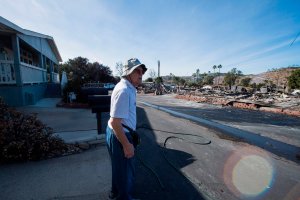Tens of thousands across Southern California are returning to ash-tainted homes after a week of widespread wildfires, wondering how to put their lives back together.

Residents should be aware that the ash, soot and dust left behind can trigger asthma attacks and irritate the skin, nose and throat, and special precautions must be taken, according to public health officials in Los Angele and San Diego counties.
Children should not be allowed to play in the ash, especially if it’s damp, and all their toys should be cleaned of any residue. Pets should be bathed.
While cleaning, residents are urged to wear protective clothing such as gloves and disposable masks and ensure their skin is fully covered. If the soot comes into contact with your skin, quickly wash it off with warm water and soap.
The use of leaf blowers, vacuums and other equipment that pushes ash back into the air should be avoided, except for HEPA-filter vacuums that can filter out small particles. Also avoid pushing the soot into storm drains.
The dust should be swept away with a damp cloth instead, then use a wet mop to further clean the area. You can disinfect the area by using a solution of bleach and water.
Collect the ash into plastic trash bags and place into your regular trash bin, if possible.
If you have a swimming pool, do not use it until all floating debris has been removed. Clean filters and use a pool net to skim the surface, then brush the sides and bottom of the pool to loosen contaminants.
Also check the filter’s pressure to ensure it is properly circulating, ensure pH is between 7.2 and 7.8 and that there is enough chlorine. You may need to repeat these steps if ash is still floating.
Any fruit or vegetables grown at home should be thoroughly washed before eating. However, ash will not harm outdoor landscaping and grass.
Power outages could create further food safety issues, and some of the dust may have found its way into your kitchen. Any plastic bottles that have been covered in ash should be thrown away as they are difficult to decontaminate.
Any tainted food should also be discarded, including items in cardboard or other soft packaging. Items in metal cans or glass jars should be safe to consume, but clean before opening and transfer them to another container.

Refrigerated food should be fine as long as there was not a lengthy power outage. If an outage lasted longer than a few hours, meat and dairy products and frozen items that have thawed should be thrown out.
For more information, contact the Los Angeles County Department of Public Health at 888-700-9995 or visit SDCountyEmergency.com.
Additional recovery information is available for Ventura County residents at VenturaCountyRecovery.org and for San Diego County residents at SDCountyRecovery.com.
Recovery resources will be available for victims of the Creek, Rye and Skirball fires at the Lake View Terrace Recreation Center at 11075 Foothill Blvd. from Tuesday, Dec. 12, to Friday, Dec. 15 between 12 and 8 p.m., as well as Saturday, Dec. 16, from 8 a.m. to 4 p.m.
Follow these tips from @lapublichealth and take precautions during clean-up after a fire. #SkirballFire #CreekFire @LAFD [PIC] pic.twitter.com/tmUyeWAB9c
— LA City Emergency Management Department (@ReadyLA) December 8, 2017
FIRE RECOVERY RESOURCES for residents and businesses impacted by the #CreekFire #SkirballFire and #RyeFire will be available at a Local Assistance Center this week
Where:
Lake View Terrace Rec CenterWhen:
Tuesday, Dec 12 – Friday, Dec 15: 12-8PM
Saturday, Dec 16: 8AM – 4PM pic.twitter.com/qFuzB3xdop— LA City Emergency Management Department (@ReadyLA) December 10, 2017















